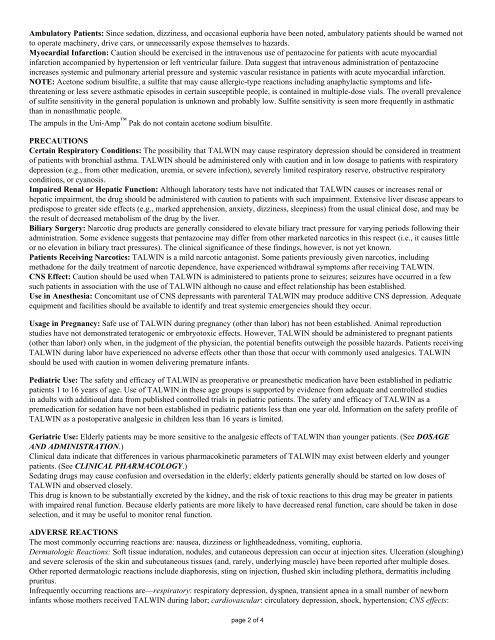Pentazocine - American Geriatrics Society
Pentazocine - American Geriatrics Society
Pentazocine - American Geriatrics Society
Create successful ePaper yourself
Turn your PDF publications into a flip-book with our unique Google optimized e-Paper software.
Ambulatory Patients: Since sedation, dizziness, and occasional euphoria have been noted, ambulatory patients should be warned not<br />
to operate machinery, drive cars, or unnecessarily expose themselves to hazards.<br />
Myocardial Infarction: Caution should be exercised in the intravenous use of pentazocine for patients with acute myocardial<br />
infarction accompanied by hypertension or left ventricular failure. Data suggest that intravenous administration of pentazocine<br />
increases systemic and pulmonary arterial pressure and systemic vascular resistance in patients with acute myocardial infarction.<br />
NOTE: Acetone sodium bisulfite, a sulfite that may cause allergic-type reactions including anaphylactic symptoms and lifethreatening<br />
or less severe asthmatic episodes in certain susceptible people, is contained in multiple-dose vials. The overall prevalence<br />
of sulfite sensitivity in the general population is unknown and probably low. Sulfite sensitivity is seen more frequently in asthmatic<br />
than in nonasthmatic people.<br />
The ampuls in the Uni-Amp Pak do not contain acetone sodium bisulfite.<br />
PRECAUTIONS<br />
Certain Respiratory Conditions: The possibility that TALWIN may cause respiratory depression should be considered in treatment<br />
of patients with bronchial asthma. TALWIN should be administered only with caution and in low dosage to patients with respiratory<br />
depression (e.g., from other medication, uremia, or severe infection), severely limited respiratory reserve, obstructive respiratory<br />
conditions, or cyanosis.<br />
Impaired Renal or Hepatic Function: Although laboratory tests have not indicated that TALWIN causes or increases renal or<br />
hepatic impairment, the drug should be administered with caution to patients with such impairment. Extensive liver disease appears to<br />
predispose to greater side effects (e.g., marked apprehension, anxiety, dizziness, sleepiness) from the usual clinical dose, and may be<br />
the result of decreased metabolism of the drug by the liver.<br />
Biliary Surgery: Narcotic drug products are generally considered to elevate biliary tract pressure for varying periods following their<br />
administration. Some evidence suggests that pentazocine may differ from other marketed narcotics in this respect (i.e., it causes little<br />
or no elevation in biliary tract pressures). The clinical significance of these findings, however, is not yet known.<br />
Patients Receiving Narcotics: TALWIN is a mild narcotic antagonist. Some patients previously given narcotics, including<br />
methadone for the daily treatment of narcotic dependence, have experienced withdrawal symptoms after receiving TALWIN.<br />
CNS Effect: Caution should be used when TALWIN is administered to patients prone to seizures; seizures have occurred in a few<br />
such patients in association with the use of TALWIN although no cause and effect relationship has been established.<br />
Use in Anesthesia: Concomitant use of CNS depressants with parenteral TALWIN may produce additive CNS depression. Adequate<br />
equipment and facilities should be available to identify and treat systemic emergencies should they occur.<br />
Usage in Pregnancy: Safe use of TALWIN during pregnancy (other than labor) has not been established. Animal reproduction<br />
studies have not demonstrated teratogenic or embryotoxic effects. However, TALWIN should be administered to pregnant patients<br />
(other than labor) only when, in the judgment of the physician, the potential benefits outweigh the possible hazards. Patients receiving<br />
TALWIN during labor have experienced no adverse effects other than those that occur with commonly used analgesics. TALWIN<br />
should be used with caution in women delivering premature infants.<br />
Pediatric Use: The safety and efficacy of TALWIN as preoperative or preanesthetic medication have been established in pediatric<br />
patients 1 to 16 years of age. Use of TALWIN in these age groups is supported by evidence from adequate and controlled studies<br />
in adults with additional data from published controlled trials in pediatric patients. The safety and efficacy of TALWIN as a<br />
premedication for sedation have not been established in pediatric patients less than one year old. Information on the safety profile of<br />
TALWIN as a postoperative analgesic in children less than 16 years is limited.<br />
Geriatric Use: Elderly patients may be more sensitive to the analgesic effects of TALWIN than younger patients. (See DOSAGE<br />
AND ADMINISTRATION.)<br />
Clinical data indicate that differences in various pharmacokinetic parameters of TALWIN may exist between elderly and younger<br />
patients. (See CLINICAL PHARMACOLOGY.)<br />
Sedating drugs may cause confusion and oversedation in the elderly; elderly patients generally should be started on low doses of<br />
TALWIN and observed closely.<br />
This drug is known to be substantially excreted by the kidney, and the risk of toxic reactions to this drug may be greater in patients<br />
with impaired renal function. Because elderly patients are more likely to have decreased renal function, care should be taken in dose<br />
selection, and it may be useful to monitor renal function.<br />
ADVERSE REACTIONS<br />
The most commonly occurring reactions are: nausea, dizziness or lightheadedness, vomiting, euphoria.<br />
Dermatologic Reactions: Soft tissue induration, nodules, and cutaneous depression can occur at injection sites. Ulceration (sloughing)<br />
and severe sclerosis of the skin and subcutaneous tissues (and, rarely, underlying muscle) have been reported after multiple doses.<br />
Other reported dermatologic reactions include diaphoresis, sting on injection, flushed skin including plethora, dermatitis including<br />
pruritus.<br />
Infrequently occurring reactions are—respiratory: respiratory depression, dyspnea, transient apnea in a small number of newborn<br />
infants whose mothers received TALWIN during labor; cardiovascular: circulatory depression, shock, hypertension; CNS effects:<br />
page 2 of 4

















